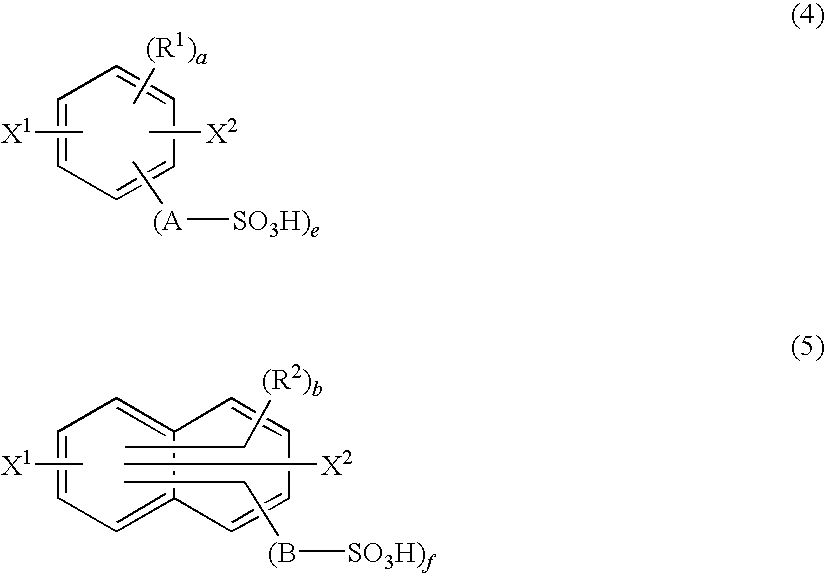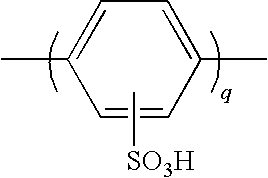Method for Producing Polymer Compound
a polymer compound and compound technology, applied in the direction of sustainable manufacturing/processing, non-metal conductor manufacturing, final product manufacturing, etc., can solve the problems of poor heat resistance, high cost of polymer electrolyte, and obtained polymer compound, and achieve excellent properties and high molecular weight
- Summary
- Abstract
- Description
- Claims
- Application Information
AI Technical Summary
Benefits of technology
Problems solved by technology
Method used
Image
Examples
example 1
[0076]Under an argon atmosphere, 3.84 g (14.5 mmol) of potassium 2,5-dichlorobenzenesulfonate, 6.23 g (39.88 mmol, 2.75 eq) of 2,2′-bipyridyl, and 70 mL of DMSO were put into a flask, followed by heating up to a temperature of 80° C. under stirring and then addition of 9.97 g (36.25 mmol, 2.5 eq) of bis(1,5-cyclooctadiene)nickel(0) at the temperature. The mixture, thereafter, was kept at the temperature for 5 hours under stirring. After being standing to be cooled to a room temperature, the reactant mixture was poured into an excess amount of methanol to generate a black color polymer; the polymer generated was collected by filtration, washed with aqueous HCl solution of 6 mol / dm3, and then dispersed into aqueous HCl solution of 6 mol / dm3 to be subjected to dialysis with a dialysis membrane to remove salts; thereafter water contained was removed under reduced pressure to obtain 1.19 g of polyparaphenylene sulfonic acid. The molecular weight of the polymer obtained is shown below, of...
example 2
[0078]Except for heating up to a temperature of 45° C., adding bis (1,5-cyclooctadiene)nickel (0) at the temperature, and then heating up to a temperature of 80° C. over 1 hour, followed by being kept at the latter temperature for 5 hours, the experiment was carried out according to the manner of Example 1 to obtain 1.03 g of polyparaphenylene sulfonic acid. The molecular weight of the polymer obtained is shown below, of which value was same to the molecular weight of a sample sampled in 3 hours after keeping temperature.
Mn=7.0×104q+r400(r=0)
[0079]The polymer compound obtained had favorable film forming ability, no cracks, favorable solvent resistability with no weight loss.
example 3
[0080]Except for using 1.50 g (5.66 mmol) of potassium 2,5-dichlorobenzenesulfonate, 3.98 g (15.84 mmol) of 2,5-dichlorobenzophenone, and 9.72 g (62.23 mmol, 2.89 eq) of 2,2′-bipyridyl, heating up to a temperature of 60° C. and then adding 15.56 g (56.57 mmol, 2.63 eq) of bis(1,5-cyclooctadiene)nickel(0) at the temperature, followed by heating up to a temperature of 80° C. over 1 hour, and thereafter being kept at the latter temperature for 6 hours, the experiment was carried out according to the manner of Example 1. After being standing to be cooled, the reactant mixture was poured into aqueous HC1 solution of 6 mol / dm3 to precipitate, the precipitated was collected by filtration, washed several times with aqueous HCl solution of 6 mol / dm3, dispersed into boiling water for 2 hours under stirring, and then collected by filtration. This sequence of washing treatments was repeated twice to obtain 3.70 g of polyparaphenylene sulfonic acid. The molecular weight of the polymer obtained i...
PUM
| Property | Measurement | Unit |
|---|---|---|
| temperature | aaaaa | aaaaa |
| ion-exchange capacity | aaaaa | aaaaa |
| temperature | aaaaa | aaaaa |
Abstract
Description
Claims
Application Information
 Login to View More
Login to View More - R&D
- Intellectual Property
- Life Sciences
- Materials
- Tech Scout
- Unparalleled Data Quality
- Higher Quality Content
- 60% Fewer Hallucinations
Browse by: Latest US Patents, China's latest patents, Technical Efficacy Thesaurus, Application Domain, Technology Topic, Popular Technical Reports.
© 2025 PatSnap. All rights reserved.Legal|Privacy policy|Modern Slavery Act Transparency Statement|Sitemap|About US| Contact US: help@patsnap.com



